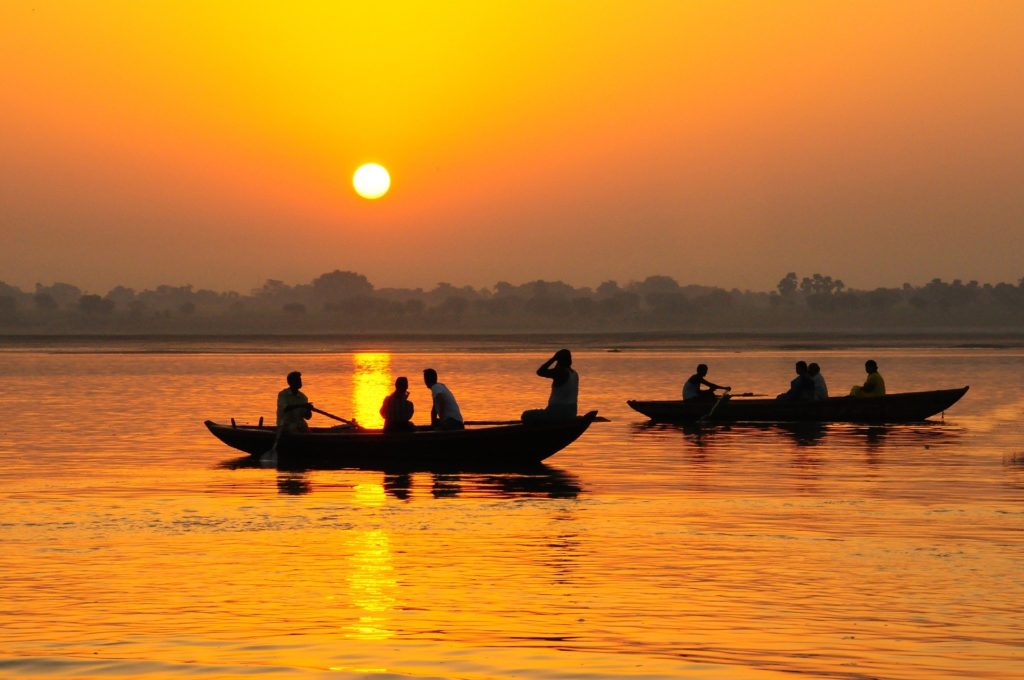River Ganga also called the Ganges may just be a water body for people outside India, but for Indians, river Ganges is a spiritual destination. Along with being one of the longest rivers, it is also the holiest rivers in India. The sacred river’s basin covers almost one-fourth of the Indian plain and caters to the needs of millions of Indians.

The worshipping of the river as a goddess is a gesture of gratefulness for all the blessings, she bestows upon the earth. The blessings range from supplying water for daily life activities to purifying your soul. It is believed that each drop produced in the river is chaste and can absorb your sins to lead you towards heaven. the story of her origin beautifully elaborated in Indian mythology seconds Ganga’s power of purity.
Bhagirath’s Tapasya
Once upon a time, a generous and religious King was roaming around his palace distressed and despondent. King Bhagirath was concerned about the immured souls of his ancestors. The souls which were cursed by Sage Kapila and burned into ashes. The curse that stood like a wall in the path of those souls towards heaven.
Bhagirath was determined to release the souls from confinement and open the gate to heaven. When the King worshipped sage Kapila, he revealed the only way to topple the wall and clear the way. King Bhagirath followed his instructions and began to worship Lord Brahma. His years of Tapasya obliged Lord Brahma to bless him with the key of the door to heaven. Lord Brahma agreed to invite the holy Ganga on the sinful land of earth.
Along with the blessing, Lord Brahma gave Bhagirath a warning that the fragile earth would not be able to bear the strength of Goddess Ganga flow. Lord Brahma advised the King to worship Lord Shiva and seek his help. The earnest King went back to worship and with the power of his devotion, he convinced Lord Shiva to pacify the boundless strength of Ganga. Lord Shiva unwrapped his Jata allowing the stream of Ganga to settle in his pious flocks. Then he slowly loosed one strand from which the first drop of river Ganges dropped on the earth.
The Religious Route of River Ganges
According to mythology, Ganga flows from that single strand of lord Shiva. And according to geography, it spurs from the Gangotri glacier perched on the Himalayas. The sacred river flows through numerous cities purifying and adding religious value to them. River Ganges blesses Haridwar, Prayagraj, Varanasi, Rishikesh, and many other sacred cities in the country. The river flows for more than fifteen hundred miles and empties into the Bay of Bengal.
The Importance of Ganga Water
Releasing from the strand of Lord Shiva the scared water reached the Asharam of Sage Kapila and allowed the trapped souls to freely walk towards heaven. The Ganga water accepts all. It accepts all the sins and all the evil deeds. One dip into the holy Gangajal and you will be as pure as an infant.
These beliefs of Hindus are very strong and lure everyone to the angelic river Ganges. In Hinduism, the river Ganges is a gateway to heaven. It is one of the tirthasthal (pilgrimage destinations) that brings you one step closer to attaining Moksha. The holy water of Ganges, Gangajal is used for all the important rituals to maintain chastity. The banks of river Ganges are well constructed and are known as Ghats. Since Ancient times the Ganges served the civilizations and kingdoms, so a few ancient architectural wonders can be found on these Ghats.
Your journey to heaven will start when you leave the mortal world. In Hinduism, the ashes are offered to the holy river, Ganga after performing cremation. Varanasi is one of the most sacred cities and the perfect destination to surrender your body and bid goodbye to the mortal realm. The Manikarnika ghat in Varanasi is famous for performing cremations and pouring the ashes into the accepting waves of Ganges.
The Holy Rituals
Celebrating the glory of the river numerous rituals and festivals such as the grand Kumbh Mela, are organized on the pristine banks of Ganga. Ganga Arti is the most popular and fascinating ritual performed on the banks. When the sun is ready to leave and calls darkness to take over, the mystical flames of aarti compliments that orange sky. While the darkness spreading over your head, the chanting of hymns will soothe your soul and fill you with the light of hope.
When the beautiful reflection of the moon on the sacred water steals your heart, the devotion of priests will clean your heart. Ganga aarti is not only a way to worship goddess Ganga but also, it’s the alarm that wakes you up from the sinful life and guides you towards the peaceful path. The experience of Ganga Arti is startling as well as satisfying.
The River Goddess
River Ganges is much more than just a water body to the Indians. She is a Goddess, she is a mother, she is an accepter, she is a protector, she is the power and she is the supplier. But unfortunately, the disregard of people has polluted the boundless acceptance of Ganga as well.
The government of India has initiated the Namami Gange program to clean the sacred river and retrieve its purity. Along with being one of the largest water suppliers in the country, the river holds an eminent religious value. The selfless River Ganges flows across India and serves mankind but expects nothing in return. This is the perfect reason to worship her as a Goddess and respect her as your mother.

Pingback: The Tradition of Pilgrimage - Auchitya
Pingback: A Day in Varanasi - Visiting Ganga Ghats and Temples - Auchitya